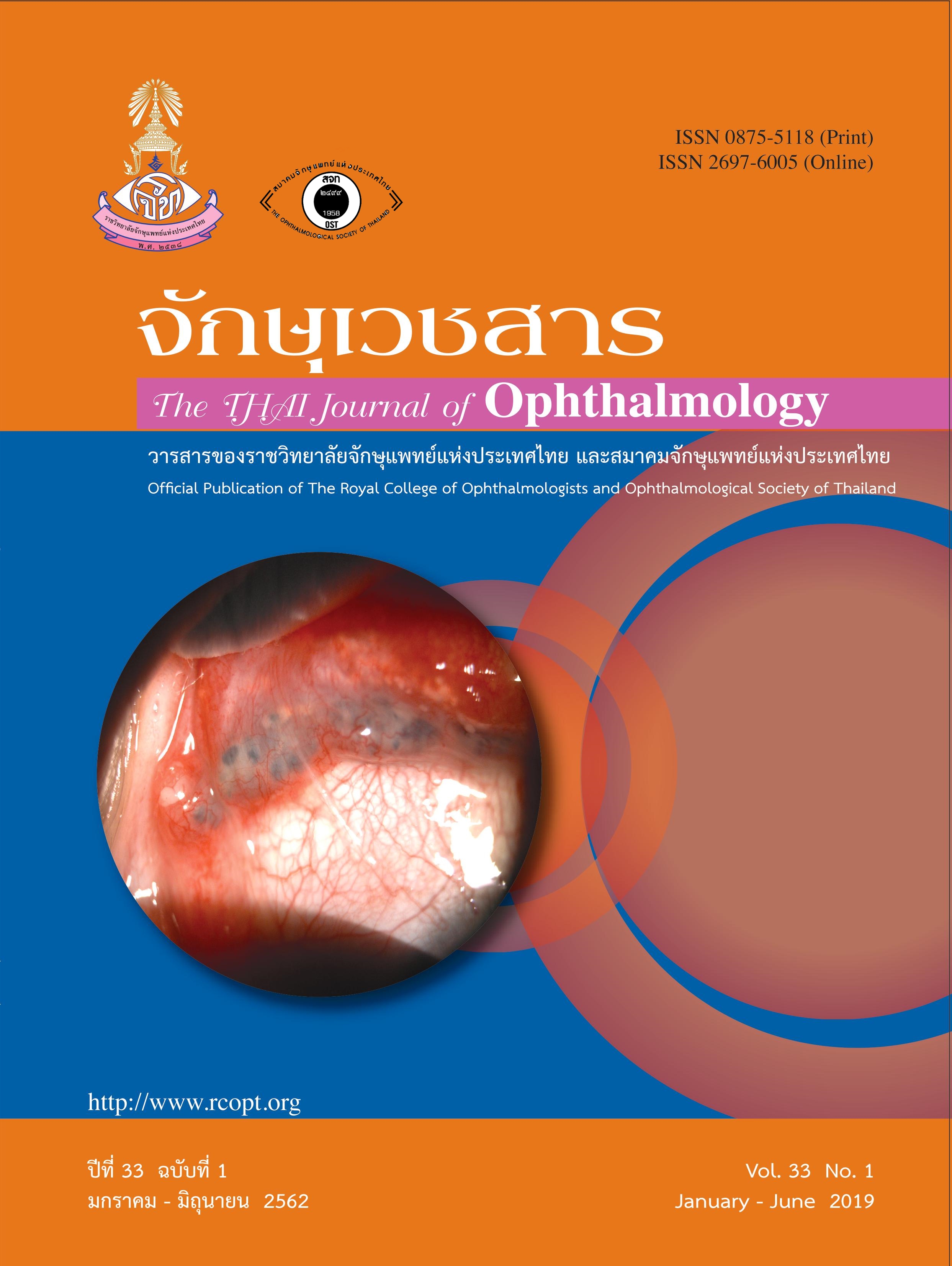The Nut and Bolts of Pediatric Cataract Management
Abstract
ภาวะตาบอดในเด็ก (childhood blindness) ตามองค์การอนามัยโลกได้ให้คำจำกัดความเด็กที่มีอายุน้อยกว่า 16 ปี ที่มีระดับการมองเห็นแย่กว่า 3/60 เข้าข่ายภาวะตาบอด (blindness) และเด็กที่มีระดับการมองเห็นแย่กว่า 6/60 เข้าข่ายภาวะสายตาพิการรุนแรง (severe visual impairment)
จากการสำรวจสาเหตุของภาวะตาบอดในเด็กโดยการแบ่งตามรายได้ของกลุ่มประเทศพบว่า ภาวะต้อกระจกอยู่ในอันดับ 1 ใน 3 ของภาวะตาบอด และพบอัตราการเกิดต้อกระจกในเด็ก 1 ถึง 6 คนต่อ 10,000 คนของเด็กแรกคลอด ทั้งนี้ภาวะต้อกระจกเป็นภาวะตาบอดที่สามารถรักษาและป้องกันได้1 การตรวจคัดกรองเพื่อการวินิจฉัยและการรักษาต้อกระจกในเด็กอย่างเหมาะสม สามารถทำให้เด็กมีการมองเห็นที่ดีขึ้นและลดอัตราการเกิดภาวะตาบอดในเด็กได้
References
Clare Gilbert, Allen Foster. Childhood blindness in the context of VISION 2020 — The Right to Sight. Bulletin of the World Health Organization, 2001, 79:227-2.
Lambert SR. Talyor and Hoyt’s Pediatric ophthalmology and strabismus. 5th edition, 2017.
Infant Aphakia Treatment Study Group et al. “Comparison of contact lens and intraocular lens correction of monocular aphakia during infancy: a randomized clinical trial of HOTV optotype acuity at age 4.5 years and clinical findings at age 5 years.” JAMA ophthalmology vol. 132,6 (2014): 676-82.
Lambert SR, Archer SM, Wilson ME, et al. Long-term Outcomes of Undercorrection Versus Full Correction After Unilateral Intraocular Lens Implantation in Children. Am J Ophthalmol. 2012;153(4):602–608.e1.
Tadros D, Trivedi RH, Wilson ME. Primary versus secondary IOL implantation following removal of infantile unilateral congenital cataract: outcomes after at least 5 years. J AAPOS. 2016 Feb;20(1):25-9.
Solebo AL, Russell-Eggitt I, Cumberland PM, et al. Risks and outcomes associated with primary intraocular lens implantation in children under 2 years of age: the IoLunder2 cohort study. Br J Ophthalmol. 2015 Nov;99(11):1471-6.
Kumar P, Lambert SR. Evaluating the evidence for and against the use of IOLs in infants and young children. Expert Rev Med Devices. 2016;13(4):381–389.
Mohammadpour, Shaabani, Sahraian, et al. Updates on managements of pediatric cataract. Journal of Current Ophthalmology. 31. 10.1016/j.joco.2018.11.005.
Lekskul A, Chuephanich P, Charoenkijkajorn C. Long-term outcomes of intended undercorrection intraocular lens implantation in pediatric cataract. Clinical Ophthalmol. 2018;12:1905–1911.
Dahan E, Drusedau MU. Choice of lens and dioptric power in pediatric pseudophakia. J Cataract Refract Surg. 1997;23 Suppl 1:618-23.
Pandey SK, Wilson ME, Trivedi RH, et al. Pediatric cataract surgery and intraocular lens implantation: current techniques, complications, and management. Int Ophthalmol Clin. 2001;41(3):175e196.
Enyedi LB, Peterseim MW, Freedman SF, Buckley EG. Refractive changes after pediatric intraocular lens implantation. Am J Ophthalmol.1998;126(6):772e781.
Crouch ER, Crouch Jr ER, Pressman SH. Prospective analysis of pediatric pseudophakia: myopic shift and postoperative outcomes. J AAPOS. 2002;6(5):277e282.
Plager DA, Kipfer H, Sprunger DT, et al. Refractive change in pediatric pseudophakia: 6-year follow-up. J Cataract Refract Surg. 2002;28(5):810e815.
Lloyd IC, Lambert SR. Congenital Cataract: A Concise Guide to Diagnosis and Management. Springer 2016.
M.Edward Wilson, Rupal H. Trivedi. Pediatric cataract surgery: techniques, complications, and management. 2014.
Tassignon MJ, De Veuster I, Godts D, et al. Bag-in-the-lens intraocular lens implantation in the pediatric eye. J Cataract Refract Surg. 2007 Apr;33(4):611-7.
Vishwanath M, Cheong-Leen R, Taylor D, et al. Is early surgery for congenital cataract a risk factor for glaucoma? Br J Ophthalmol. 2004 Jul;88(7):905-10.
Asrani S, Frredman S, Hasselblad V, et al. Does primary intraocular lens implantation prevent aphakic glaucoma in children? J AAPOS 2000,4:33-39.
Neely DE, Plager DA, Borger SM, et al. Accuracy of intraocular lens calculations in infants and children undergoing cataract surgery. J AAPOS9:160-5,2005.
Andreo LK, Wilson ME, Saunders RA. Predictive value of regression and theoretical IOL formulas in pediatric intraocular lens implantation. J Pediatr Ophthalmol Strabismus 1997 Jul-Aug;34(4):240-3.
Mezer E, Rootman DS, Abdolell M, et al. Early postoperative refraction outcomes of pediatric intraocular lens implantation. J Cataract Refrac Surg 30:603-10,2004.
Freedman SF, Lynn MJ, Beck AD, et al; Infant Aphakia Treatment Study Group. Glaucoma-Related Adverse Events in the First 5 Years After Unilateral Cataract Removal in the Infant Aphakia Treatment Study. JAMA Ophthalmol. 2015 Aug;133(8):907-14.
Hejtmancik JF. Congenital cataracts and their molecular geneics. Semin Cell Dev Biol.2008;19(2):134-149.
Lambert SR. Management of monocular congenital cataracts. Eye (Lond). 1999 Jun;13 ( Pt 3b):474-9.
Hutcheson KA, Drack AV, Elish NJ, et al. Anterior hyaloid face opacification after pediatric Nd: YAG laser capsulotomy. J AAPOS 1999, 3:303-307.
Parakal M, Nair S. Outcomes of multifocal intraocular lens implantation in pediatric eyes. Kerala J Ophthalmol 2019;31:39-44.
Abouzeid H, Moetteli L, Munier F. New-Generation Multifocal Intraocular Lens for Pediatric Cataract. Ophthalmologica 2013;230:100–107.
Downloads
Published
Issue
Section
License
The Thai Journal of Ophthalmology (TJO) is a peer-reviewed, scientific journal published biannually for the Royal College of Ophthalmologists of Thailand. The objectives of the journal is to provide up to date scientific knowledge in the field of ophthalmology, provide ophthalmologists with continuing education, promote cooperation, and sharing of opinion among readers.
The copyright of the published article belongs to the Thai Journal of Ophthalmology. However the content, ideas and the opinions in the article are from the author(s). The editorial board does not have to agree with the authors’ ideas and opinions.
The authors or readers may contact the editorial board via email at admin@rcopt.org.


